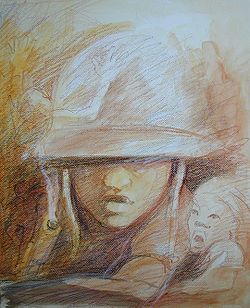Children in the military
From Wikipedia, the free encyclopedia
Children (defined by the Convention on the Rights of the Child as people under the age of 18) have been recruited for participation in military operations and campaigns throughout history and in many cultures.[1]

| Part of a series on |
| Child soldiers |
|---|
| Main articles |
| Issues |
| Instances (examples) |
| Legal aspects |
| Movement to end the use of child soldiers |
| Part of a series on |
| War |
|---|
|
Children in the military, including state armed forces, non-state armed groups, and other military organizations, may be trained for combat, assigned to support roles such as porters or messengers, or used for tactical advantage as human shields or for political advantage in propaganda.[2][3]
Children are targeted for their susceptibility to influence, which renders them easier to recruit and control.[4][5][1][6] While some are recruited by force, others choose to join up, often to escape poverty or because they expect military life to offer a rite of passage to maturity.[1][7][8][9][10]
Child soldiers who survive armed conflict frequently develop psychiatric illness, poor literacy and numeracy, and behavioral problems such as heightened aggression, which together lead to an increased risk of unemployment and poverty in adulthood.[11]
Research in the United Kingdom has found that the enlistment and training of adolescent children, even when they are not sent to war, is often accompanied by a higher risk of suicide,[12][13] stress-related mental disorders,[14][15] alcohol abuse,[16][17] and violent behavior.[18][19][20]
Since the 1960s, a number of treaties have successfully reduced the recruitment and use of children worldwide.[21] Nonetheless, a quarter of armed forces worldwide, particularly those of economically powerful states, still train adolescent children for military service,[22][23][24] while elsewhere the use of children in armed conflict and insurgencies has increased in recent years.[22][25][26]
